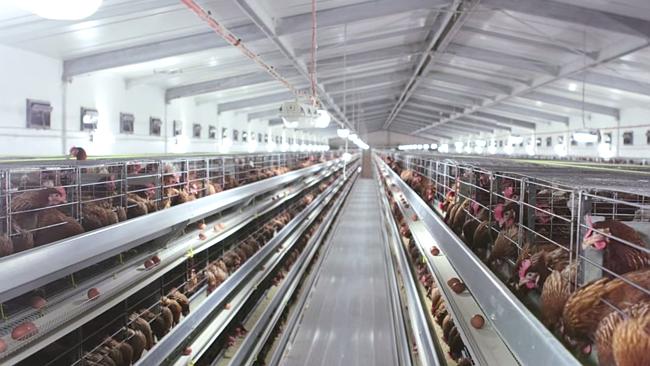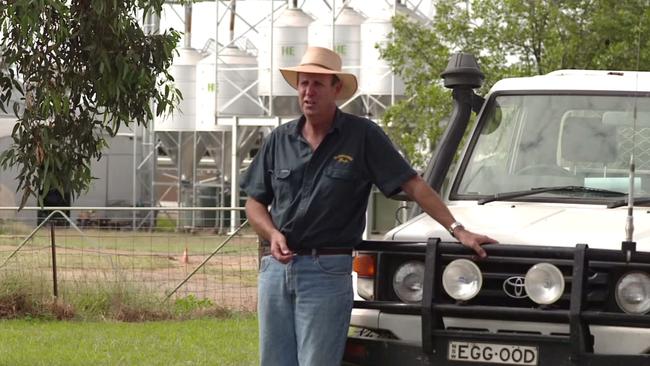Do cage eggs have a future in Australia?
IT’S a controversial practice many consumers claim they want to see the back of — but their behaviour says otherwise.

THE RSPCA is calling for cage eggs to be banned once and for all as the government undertakes the first review of poultry farming standards in more than 10 years.
With McDonald’s, Woolworths, Coles and Subway all taking steps to phase out cage eggs from their supply chains, animal rights groups say the tide is turning against the practice.
But industry groups argue there is no way to meet the demand for eggs with free-range or barn-laid varieties. Australians eat an average of 213 eggs every year, and to transfer the 11 million hens in cages would be logistically impossible, producers claim.
They have likened the situation to the debate around renewable energy — just as coal must continue to provide base-load power for the foreseeable future, there’s no way we can meet our desire for eggs without cages.
Bede Burke is an egg producer from Tamworth in NSW whose family has been in the business since his grandfather set up their farm in the 1960s.
He argues the debate is much more complicated than animal rights groups make out. “Once consumers hear the full story they start to realise it’s not simply a matter of having the bird outside of confinement,” he said.
“There’s a lot more to it if we’re going to deliver serious quantities of eggs, 24 hours a day, 365 days a year. It’s very much like the energy production sector — we all wish there was no pollution, but sadly we don’t have a replacement.
“We’re gradually moving there, and the egg industry is moving there, but it’s a gradual process.”
Mr Burke, who has 106,000 cage hens and 27,000 barn hens, said he had an “open-door policy”. “Yes, confinement is something we can’t win the argument on. From the day that they’re housed, they’re in that cage for the rest of their life,” he said.
“But in all other welfare aspects — food, safety, health, not to mention delivering a price that our consumers expect — I can assure you our cages will exceed your expectations.”
Mr Burke also argues free range isn’t all its cracked up to be, with hens prone to disease from drinking water contaminated with their own faeces.
“[When they’re in cages], at least you have some way of controlling those internal and external parasites and bugs,” he said.
What many people didn’t realise, he added, was that the cage egg production system often carried the free range. “Nearly every single producer that has a significant number of free-range hens also has a cage production system,” he said.

Animals Australia spokeswoman Lisa Chalk said Australia was lagging behind other developed nations on the issue. “Continuing to confine millions of birds this way in Australia is indefensible, especially when other countries have long recognised and acted on this cruelty,” she said.
“You cannot look at poor hens crammed together in cages and morally justify the lives they are forced to lead. We bring these birds into this world only to suffer. Cage eggs may be cheaper, but it is the birds that are paying a dreadful price.”
Ms Chalk said on animal welfare issues, consumers had driven change much quicker than legislators had been prepared to.
“The Poultry Code was last reviewed in 2001, at which time the European Union made the decision to phase out the barren battery cage, but in Australia the decision was made to just increase cage sizes slightly — by about the size of a matchbox per hen,” she said.
“So at a time the rest of the world recognised that battery cages were cruel and needed to be phased out, Australia was resisting change. That’s why in 2015 we’re still having this conversation.”
Ms Chalk said the big problem was that consumers had over many years become accustomed to buying cheap eggs, but “they were never told the truth, that cheaper equals crueller”.
“What we’ve found however is that as people become informed, overwhelmingly they are choosing not to support cruel systems.”
Woolworths says it is on track to be entirely cage-free by 2017, while Coles has committed only to remove cage eggs from its home-brand range.
Fast-food giant McDonald’s says 25 per cent of its eggs are now cage free, and that it is on track to meet its target of a 2017 phase-out. In the US and Canada, McDonald’s has committed to be cage-free by 2025.
More than 40 IGA stores around the country have stopped stocking cage eggs in a move prompted by graphic footage obtained last year by Animals Australia of a Pace Farms egg supplier.
Earlier this year, Aldi came under fire after a social media campaign by the RSPCA called on shoppers to demand the German discounter ban cage eggs. Bulk discount chain Costco also refused to cave to pressure.

The Poultry Code was last reviewed in 2001. The current review, which brings together federal, state and territory governments, is being led by Animal Health Australia and the NSW Department of Primary Industries.
The European Union moved to outlaw battery farms in 1999, with the 13-year phase-out taking effect in 2012. Hens may still be kept in so-called furnished cages.
According to the Australian Egg Corporation, 53 per cent of eggs sold are cage eggs, 38 per cent are free range, 8 per cent are barn-laid and 1 per cent are specialty. The proportion of cage-free eggs sold has steadily been growing.
A spokeswoman for the RSPCA said cages must be removed from egg production once and for all. “With so many major retailers, food outlets and manufacturers already switching to cage-free eggs, or committing to in the near future, it’s clear that Australian consumers don’t support the cruel confinement of layer hens in cages,” she said.
“When the poultry code was last reviewed more than a decade ago, the RSPCA fought hard to have cages disallowed. Sadly, a small increase in cage size was the only change to be implemented. As far as the RSPCA is concerned, a cage is a cage — no increase in size or addition of furnishings will make it an adequate environment for inquisitive creatures like hens to spend their lives.”
Emmanuel Giuffre, legal counsel with animal rights group Voiceless, said cages were “legalised cruelty”. “It’s the biggest shame of the animal welfare regulatory framework that you can do to a pig or a chicken or a cow what would be horrendous and horrific and illegal if performed on a dog or a cat,” he said.
“There’s a disconnect between the animal welfare standards that currently apply and what the community expects.”
He said part of the problem of the poultry code review process was the disproportionate representation from industry groups from the very beginning, with most animal welfare groups only being invited to make submissions along with the wider community at the final public consultation phase.
“Standards and guidelines are developed by industry, often using science funded by industry, without adequate consultation with animal welfare groups,” he said. “The initial draft obviously sets the tone.”
A spokesman for Agriculture Minister Barnaby Joyce said it was the role of the government to support the ongoing growth and development of the $1.6 billion egg industry “in line with community expectations”.
“The Australian Government recognises that all egg productions systems have an important role to play,” he said. “The review of the code is in its initial stages and state and territory governments have responsibility for domestic animal welfare issues.”




